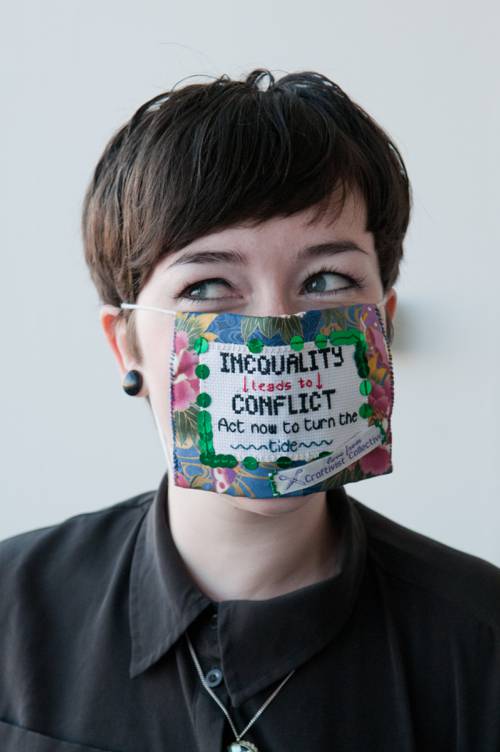
FAQ About The Role of Craftivism in Political Discourse

What is craftivism?
Craftivism is a form of activism where craft projects are used to promote social, political, or environmental messages. It combines craft—such as knitting, sewing, embroidery—with activism to create political or social change. The term was popularized by activist Betsy Greer in the early 2000s. It draws on the comforting and handmade nature of crafts to communicate ideas and motivate change on a more personal and emotional level.

How does craftivism influence political discourse?
Craftivism influences political discourse by offering a gentle yet powerful method of communication. It challenges traditional forms of protest by engaging people in thoughtful dialogue and reflection about serious issues. Craft projects often carry deep symbolic meaning, helping to convey complex messages in more accessible forms. These crafts can be used to start conversations, evoke empathy, and inspire action, making them a unique tool in political advocacy.

Can you give examples of craftivism in action?
Examples of craftivism include the Pussyhat Project, where pink knitted hats were used during the Women's March to promote women's rights. Another example is AIDS Memorial Quilt, which commemorates those who have died of AIDS and has raised awareness about the disease. These projects use crafting as a public display to engage a wider audience in ongoing political and social issues.

What are the benefits of using craftivism within communities?
Craftivism brings multiple benefits to communities, including the creation of a sense of unity and solidarity among participants. It also enhances social awareness and encourages civic engagement by involving people in collective craft projects that address societal issues. Additionally, crafting can be therapeutic, providing mental health benefits through creativity and community support.

Why is craftivism considered a non-traditional form of activism?
Craftivism is considered a non-traditional form of activism because it diverges from more direct and confrontational methods like protests and demonstrations. Instead, it uses the softer approach of crafting to express dissent and inspire change. This type of activism is accessible, often inclusive, and encourages people who may not participate in traditional forms of activism to join in on important social discourse.

What role does the internet play in craftivism?
The internet plays a significant role in craftivism by facilitating the sharing of ideas, patterns, and projects across wide audiences. Platforms like social media help craftivists to showcase their work, spread their message, and connect with like-minded individuals globally. This connectivity broadens the reach and impact of craftivist projects, allowing for a more significant contribution to political discourse.

How can I get involved in craftivism?
You can get involved in craftivism by starting or joining a local craftivist group. Participate in projects that resonate with you or create your own craft project centered around an issue you care about. The internet is a valuable resource for finding patterns and communities dedicated to various causes. Look for craftivism events, workshops, or social media groups to connect with other craftivists.

What's the history behind the term 'craftivism'?
The term 'craftivism' was coined by Betsy Greer in 2003. It blends crafting with activism to promote social change through personal expression. This concept is rooted in historical practices where craft was often used as a medium for protest and political messaging. Examples are the suffragette banners and anti-war embroidery, which served as a precursor to modern-day craftivism.

What challenges does craftivism face as a form of activism?
Craftivism, like any form of activism, faces challenges such as being perceived as less effective due to its non-confrontational nature. There is also the struggle to be taken seriously in the broader political discourse. Additionally, craftivism can be limited by resources, including time and material costs, which may not be accessible to everyone interested in participating.

How does craftivism differ from traditional craft?
While traditional craft focuses on the creation of items for utility or artistic expression, craftivism explicitly combines these skills with a strong message of activism. The intention behind craftivism is to challenge societal norms and provoke thought or action concerning political or social issues, rather than simply creating for self-pleasure or aesthetic satisfaction.

Are there any famous craftivists?
Yes, several craftivists have gained recognition for their work. Betsy Greer, who coined the term craftivism, is a prominent figure in the movement. Other notable craftivists include Sarah Corbett, founder of the Craftivist Collective, and Jeanne Lemlin, known for her political quilts. These individuals use their skills to raise awareness and inspire change on various issues.

Can craftivism be considered a form of social justice?
Craftivism can indeed be considered a form of social justice as it seeks to address and rectify societal issues through art and creativity. By using craft to highlight injustices and push for change, craftivists participate in the larger social justice framework aiming to promote equality and human rights.

What materials are typically used in craftivist projects?
Craftivist projects can involve various materials, including yarn, fabric, paper, and recycled materials. The choice of materials often reflects the theme of the project, such as using sustainable or upcycled materials to promote environmental awareness. The flexibility in materials allows for diverse expression and creativity within the craftivism movement.

How can craftivism be educational?
Craftivism can be educational by raising awareness and sparking dialogue around political and social issues. It encourages participants to research and understand the topics they are crafting about, which can lead to greater knowledge and empathy. Additionally, craftivism workshops and events can teach crafting skills alongside social consciousness, providing a platform for learning and activism.

Is craftivism limited to any specific political orientation?
Craftivism is not limited to any specific political orientation as it is a tool that can be used by individuals with diverse beliefs and objectives. The scope of craftivism covers a broad range of social, political, and environmental issues, allowing activists from various backgrounds to employ this form of expression to advocate for their particular causes or viewpoints.

What impact has craftivism had on recent social movements?
Craftivism has played a role in recent social movements by providing a visual and emotional component to advocacy efforts. Projects like the Pussyhat Project and the AIDS Memorial Quilt have gained media attention, bringing key issues to the forefront of public discourse. Such initiatives demonstrate the power of craftivism to galvanize support and increase awareness for modern social movements.

Are there any books or resources on craftivism?
Yes, there are numerous resources on craftivism. 'Craftivism: The Art of Craft and Activism' by Betsy Greer is a foundational text on the subject. Another recommended read is 'How to Be a Craftivist: The Art of Gentle Protest' by Sarah Corbett, which provides practical guidance on using crafting as activism. These books offer insights into the philosophy, history, and impact of craftivism.

Does craftivism include digital or online crafts?
Craftivism can include digital or online crafts, especially as the internet becomes more integrated into everyday life. Digital platforms allow for new forms of expression and innovation in crafting, expanding the reach and impact of craftivist messages through online engagement and virtual collaboration.

Can children participate in craftivism?
Children can certainly participate in craftivism. Crafting can be an engaging way to introduce complex social and political issues to young audiences. Projects tailored to children not only teach crafting skills but also encourage empathy, critical thinking, and community involvement. With guidance, children can use their craft projects to express their values and contribute to social change.

What is the future of craftivism?
The future of craftivism appears promising as it continues to adapt alongside technological advancements and global social movements. There is growing interest in sustainable and handmade goods, which aligns with craftivism's ethos. The movement is likely to expand its influence, engaging new generations and incorporating diverse mediums to address contemporary issues of social justice, environmental concerns, and political change.
